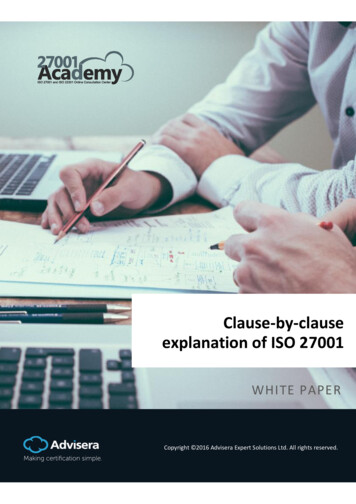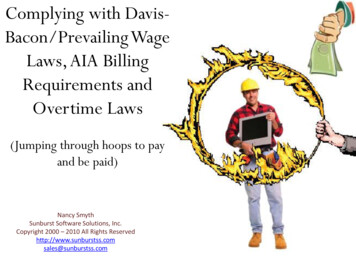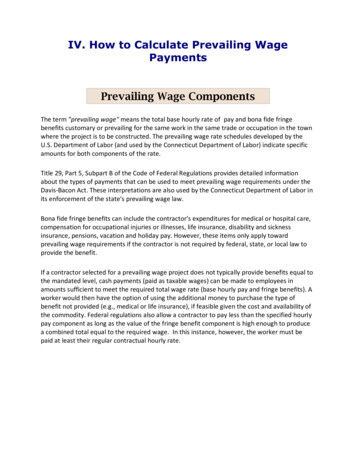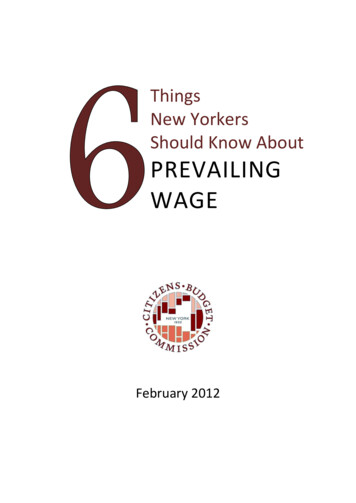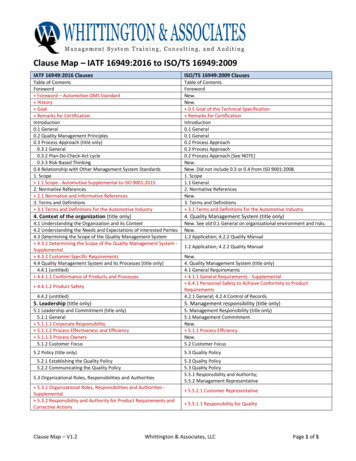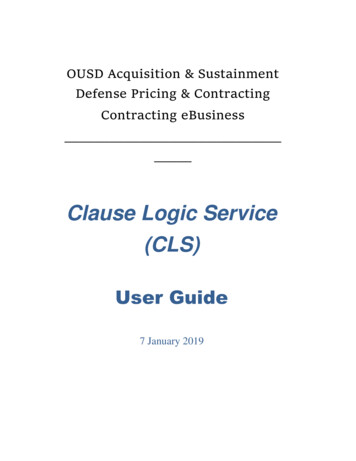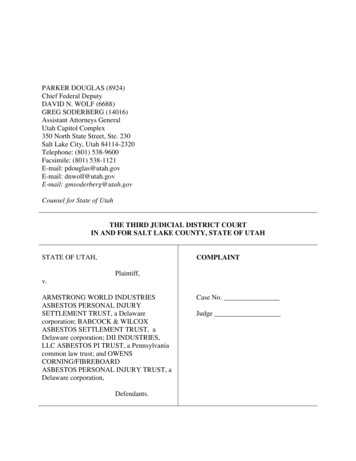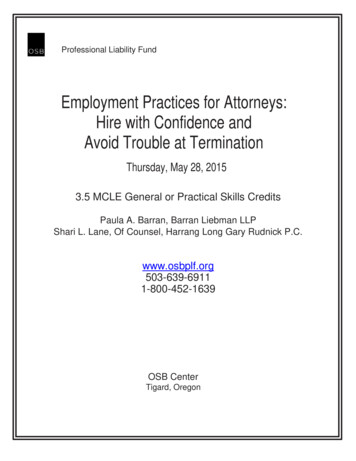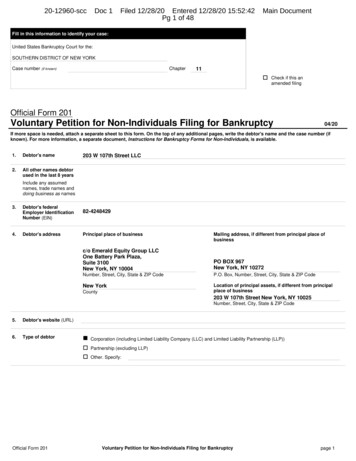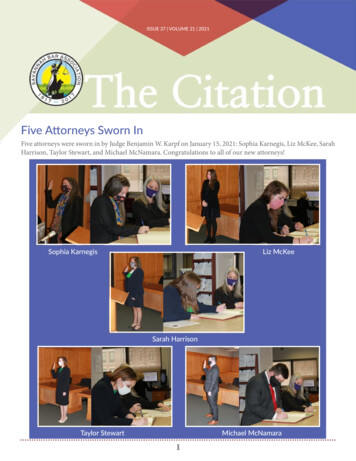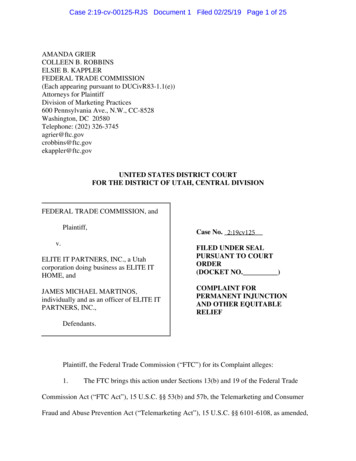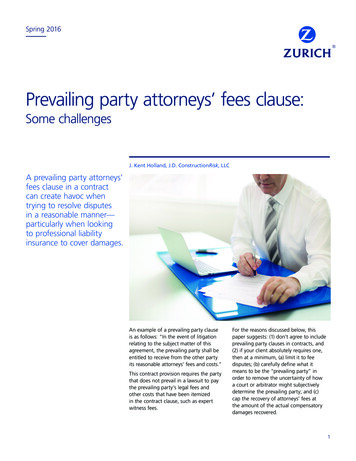
Transcription
Spring 2016Prevailing party attorneys’ fees clause:Some challengesJ. Kent Holland, J.D. ConstructionRisk, LLCA prevailing party attorneys’fees clause in a contractcan create havoc whentrying to resolve disputesin a reasonable manner—particularly when lookingto professional liabilityinsurance to cover damages.An example of a prevailing party clauseis as follows: “In the event of litigationrelating to the subject matter of thisagreement, the prevailing party shall beentitled to receive from the other partyits reasonable attorneys’ fees and costs.”This contract provision requires the partythat does not prevail in a lawsuit to paythe prevailing party’s legal fees andother costs that have been itemizedin the contract clause, such as expertwitness fees.For the reasons discussed below, thispaper suggests: (1) don’t agree to includeprevailing party clauses in contracts, and(2) if your client absolutely requires one,then at a minimum, (a) limit it to feedisputes; (b) carefully define what itmeans to be the “prevailing party” inorder to remove the uncertainty of howa court or arbitrator might subjectivelydetermine the prevailing party; and (c)cap the recovery of attorneys’ fees atthe amount of the actual compensatorydamages recovered.1
Spring 2016Contractual liability exclusionbars coverage for shiftedattorneys’ fees“Under what is knownas the American Rule,each party to litigationwill bear its own litigationcosts in the absenceof a statutory orcontractual requirement.”Professional liability insurance policies onlycover damages that a design professionalis legally obligated to pay as a result of itsnegligent acts, errors or omissions in theperformance of professional services.All professional liability policies, as far aswe know, include what is known as the“contractual liability” exclusion. Thatexclusion states there is no coveragefor liability that the insured designprofessional assumes under a contractthat it would not have had at common lawfor its negligent acts, errors or omissions.Under what is known as the AmericanRule, each party to litigation will bearits own litigation costs in the absenceof a statutory or contractual requirement.By agreeing to pay the attorneys’ feesof a client that prevails in a claim againstthe insured, the insured has created acontractual liability that is excluded fromcoverage because it is an obligation itwould not otherwise have at commonlaw, but which was created solely byvirtue of the contractual promise.Whether any claim is covered is a decisionmade by the carrier’s claims departmentafter a claim has been made against theinsured. The coverage decision is basedon the application of the law, the policyand the specific facts of the case.It is also important to consider thatbecause professional liability policiesare “claims-made,” the policy in effectwhen the claim is made could very wellbe different and written by a differentinsurance company by the time a claimfor prevailing party fees and costs ismade against the design professional.The coverage decision will be based onthe application of the law, the policy andthe specific facts of the case at the timethe claim is made. Therefore, it will bethe current insurance carrier’s policy andinterpretation of coverage that matters,rather than the company that wrote thepolicy at the time the contract betweenthe design professional and client wasentered into.The old idea that frivolous lawsuits would be discouraged byprevailing party clauses has notpanned outThere was a time when the design andconstruction community (as well as someof their legal and risk managementadvisors) recommended prevailing partyclauses as 1) a way to make plaintiffs thinktwice before filing frivolous lawsuits, and2) as a means to facilitate litigation bydesigners and contractors against theirclients who were arbitrarily refusing topay fees when due.The thinking was that the cost of pursuinglegal action to recover unpaid fees wouldbe so excessive that designers andcontractors would not be able to justifythe legal battle and would have to foregocollecting their fees. The prevailing partyclause was supposed to remedy that byforcing the recalcitrant client to pay theplaintiff’s legal fees in addition to the feesearned under the contract.Unfortunately, there was a problem withthis logic. Anyone who has spent time inthe construction industry knows thatvirtually every time a designer orcontractor sues its client for unpaid fees,there is going to be a countersuit claimingnegligent performance of services andvarious errors, omissions and deficienciesthat caused the client to incur extra projectcosts and damages.2
Spring 2016“Due to the threat of having topay an adverse party’s expensivelegal costs, some contractors anddesign firms are settling disputesfor less than their true value.”A polling of numerous design professionalinsurance carriers reveals that many of theclaims they have paid on behalf of theirinsured design professionals resulted fromcounterclaims brought by clients after thedesigner sued to recover its fee. This hasbecome so prevalent that many carriersconsider designers who sue clients fora fee to be a high risk and include aquestion on the insurance applicationasking whether the designer files suitsagainst its clients to collect fees.The irony is that not only does theprevailing party clause not help thedesigner or contractor to collect its feesthrough litigation; it has actually resultedin adverse settlements because, asdiscussed below, it may be safer to settlefor less than to potentially pay the otherparty’s attorneys’ fees at the end oflengthy and expensive litigation.The prevailing party clausemay be encouraging litigationBased on anecdotal evidence, it appearsthat rather than discouraging litigation,the prevailing party clause may actuallybe encouraging project owners to makeclaims they would have otherwiseforegone based on a cost-benefit ofanalysis of how much they would haveto pay in attorneys’ fees compared tohow much they would potentially recoverfrom the defendant. If, however, theowner can recover its attorneys’ fees,it does not matter that it may ultimatelyget a relatively small compensatorydamage recovery from the defendant.The prevailing party clause can make itworth the gamble for the plaintiff topursue a claim that it might nototherwise have pursued.Prevailing party clause mayadversely impact settlementDue to the threat of having to pay anadverse party’s expensive legal costs,some contractors and design firms aresettling disputes for less than their truevalue. They are finding it is too dangerousto take the risk that their client mightprevail on some small part of theiroverall claim and yet be deemed the“prevailing party” and receive attorneys’fees far exceeding the compensatorydamages awarded.This has a chilling effect on seeinglitigation or arbitration through to afinal determination, even if it is predictedthat the defendant would be able tosuccessfully defend against the biggestpart of the claims. The problem is thatif the defendant successfully defendsagainst 80% of the claim, so that theplaintiff only prevails on 20% of its claim,that plaintiff could still be deemed the“prevailing party” and be entitled to itsattorneys’ fees pursuant to the prevailingparty clause. How courts interpret theprevailing party clause varies widelyfrom state to state.From my own recent experience indefending claims against designprofessionals by contractors (one in courtand one in arbitration), the prevailing partyattorneys’ fees provision caused the designfirm to make a risk management decisionto settle the cases for more than theywould likely have paid if the matters wentto final judgment. This is because even asmall judgment might have resulted inhaving to pay exorbitant attorneys’ feesto the contractor as the “prevailing party.”In those cases, the prevailing partyclause could be said to have encouragedthe filing of claims against the designprofessional and then have caused thedesign professional to pay settlementamounts it felt were unjustified.It is examples like this that are causingsome insurance carriers to advise theirdesign professional insureds to strikeout the prevailing party attorneys’ feesclause in contracts when negotiatingthe contract terms and conditions.3
Spring 2016What costs are to be awardedto the prevailing party?“Courts look to whether‘substantial relief’ wasawarded and not necessarilywhat percentage of recoverythe plaintiff was awarded ascompared to its overall claim.”To avoid uncertainty concerning whatcosts are intended to be reimbursed tothe prevailing party, it is advisable that adetailed description or listing of the costbe included in the clause. For example,rather than stating that the prevailingparty will be entitled to recover“reasonable attorneys’ fees and courtcosts,” it would be better to describein greater detail the costs and expensesintended to be covered. For example,confusion could be avoided by statingthat the prevailing party will be entitledto recover “any and all costs and expensesincurred with respect to such litigationor other proceeding, including withoutlimitation, reasonable attorneys’ fees,court costs, other disbursements andcosts and expert fees and costs.”1If the clause does not specifically statethat it includes expert fees as part of therecoverable cost, it is quite possible thecourt will not allow them. In the caseof Specialty Retailers Inc. v. Main StreetNA Parkade, LLC (Massachusetts 2012),a court found that expert fees were notrecoverable under a prevailing party clausethat only entitled recovery of “reasonableattorneys’ fees and court cost” because,in the court’s opinion, expert fees do notequate to court costs. This demonstratesthe importance of being clear with regardto your intent when drafting prevailingparty clauses.Who is the prevailing party?According to Black’s Law Dictionary,the prevailing party is “a party in whosefavor a judgment is rendered, regardlessof the amount of damages awarded.”2The United States Supreme Court hasstated, “Plaintiffs may be considered‘prevailing parties’ for attorneys’ feespurposes if they succeed on any significantissue in litigation which achieves some ofthe benefit the parties sought in bringingsuit.”3 Federal Rules of Civil Procedure,Rule 54 (d)(1) provides that even in theabsence of a prevailing party clause, the“prevailing party in federal litigation isentitled to recover costs other thanattorneys’ fees.” As a result of this rule,at the conclusion of a case, federal judgesmust make a determination of who is the“prevailing party” in order to award “courtcosts.” For purposes of rule 54 (d), a partyis deemed a prevailing party if the courtawards it “substantial relief.” See Smartv. Local 702 International Brotherhood ofElectrical Workers.4A party that obtains “substantial relief”is deemed the prevailing party in federallitigation “even if it does not win onevery claim.” (Slane v. Mariah Boats, Inc.)5An excellent example of this is seen inthe case of Summerfield v. City ofChicago6, where a jury awarded a plaintiff 30,000 on two counts of a complaint,found against him on a third count andthe judge earlier dismissed two othercounts by summary judgment.This decision is instructive as to howcourts can be expected to determinewho is a prevailing party in general.Courts look to whether “substantial relief”was awarded and not necessarily whatpercentage of recovery the plaintiff wasawarded as compared to its overall claim.Thus, even if a defendant is successful indefeating most of a plaintiff’s claim, as inSummerfield, a small recovery by thatplaintiff might be sufficient for the courtto find they obtained “substantial relief”and are entitled to recover all or somesignificant portion of their attorneys’ fees.4
Spring 2016Example of plaintiffrecovering attorneys’ feesdespite losing claim forcompensatory damagesIn the case of Signature Flight SupportCorporation v. Landow Aviation LimitedPartnership 7, the impact of a prevailingparty clause was severe. The plaintiff suedto obtain declaratory relief preventing thedefendant from continuing certain actions.It also sued for compensatory damages ofover 4 million.The court granted declaratory judgmentand an injunction in favor of the plaintiffprohibiting the defendant from continuingcertain business practices that the plaintiffalleged was causing it harm. The courtfound in favor of the defendant, however,on the breach of contract and accountingclaims because the court concluded theplaintiff failed to prove the monetaryamount of its damages. The net result ofthe court decision was that the defendanthad to stop certain business practices butit did not have to pay any of thecompensatory damages claimed.At the conclusion of the trial, the plaintifffiled an application for over 1 millionin attorneys’ fees along with a bill ofalmost 200,000 for costs it expendedin the litigation. After considering thereasonableness of the fees, the courtawarded the plaintiff attorneys’ feesin the amount of 1,130,843.60 andcosts in the amount of 176,577.34.This case is a striking example ofhow attorneys’ fees can far exceedany compensatory damages awarded,and in fact might be the only financialdamages awarded.Define the prevailing party asthe overall “net” winner of thetotal law suitIn one recent decision (Sharif v. Mehusa,Inc.) 8, an appellate court in Californiaheld that both the plaintiff and defendantcould be prevailing parties in the samelegal action and both entitled to recoverattorneys’ fees from their opposing party.In the trial, a plaintiff was awardeddamages on one claim but lost anotherclaim. Each party sought to recover its feesas the prevailing party under two differentfee-shifting statutes applicable to theseparate causes of action.The plaintiff argued, however, thatshe was the prevailing party within themeaning of the applicable California codethat defined prevailing party as “the partywith the net monetary recovery.” Shefurther argued that there can be onlyone prevailing party in a civil action andbecause she had won on one of her threeclaims, she was the one that prevailed.The trial court and appellate court rejectedthe plaintiff’s argument and concludedthat because the defendant prevailedin defending two of the claims, thedefendant was also a prevailing partyunder the fee-shifting statute applicableto those two claims. The court explained,“When there are two fee-shifting statutesin different causes of action, there can bea prevailing party for one cause of actionand a different prevailing party for theother cause of action.”5
Spring 2016The need to carefullydefine specifically whois the prevailing partyAs seen from the cases discussed in thisbriefing, the question of who is theprevailing party can be quite subjective,and judges and arbitrators can have broaddiscretion in making the determination.Rather than risking the unpleasant surpriseof having one's opposing party found tobe the prevailing party despite having lostmost of their case, it is wise to defineprevailing party in a manner that removessome of the subjectivity as well as thedecision-maker’s discretion.Indemnity clauses may createuninsurable prevailing partyattorneys’ feesPursuant to a contractual indemnificationclause, a trial court awarded damages of 810,000 in attorneys’ fees against anengineer in favor of a project owner,Wal-Mart Stores, Inc., on a jury verdictthat found Qore, Inc. only liable for 48,600 in actual property damagesThe indemnification clause in questionprovided the following:“The Testing and Inspection Firm [Qore]further agrees to indemnify and holdWal-Mart free and harmless from anyclaim, demand, loss, damage, or injury(including Attorneys’ fees) caused by anynegligent act or omission by the Testingand Inspection Firm, its agents, servants,or employees.”An initial question to be determinedby the court was whether thisindemnification only applied to claimsbrought against Wal-Mart by third partiesor whether attorneys’ fees were permittedin a first-party dispute (i.e., Wal-Martdirectly against the engineer) as well.The court held that the language ofthe indemnity clause allowed recoveryin first-party actions.Wal-Mart’s first party claim against theengineer, a general contractor and otherswas for damages due to failure of aparking lot in which the engineer hadprovided geotechnical and design servicesto allow the store and lot to be built on alayer of clay just below the surface. A juryfound the total damages to the buildingwere 486,000, with engineer being 10%at fault and the general contractor being90% at fault for the damages. Thus, theengineer was liable for only 48,600 buthad to pay many multiples of that inattorneys’ fees as a result of the contractclause that the court held constituted aprevailing party attorneys’ fees clause.With regard to the parking lot, the juryfound no liability on the part of theengineer, but instead found Wal-Mart50% liable and a general contractor 50%liable and awarded Wal-Mart 1.6 millionin damages for the parking lot. In a posttrial motion, Wal-Mart sought to recoverits attorneys’ fees incurred in the litigationon all the claims (both the ones itsucceeded on and the ones it lost).The court awarded the entirety of theattorneys’ fees against the engineerpursuant to the indemnity provision ofthe contract. This decision was reversedon appeal, with the court holding thatWal-Mart’s recovery of attorneys’ feesshould be limited to those claims uponwhich it prevailed against the engineer.The court did not suggest, however,that this limitation would prevent anaward of attorneys’ fees that wouldexceed the compensatory damages onthose claims. See Wal-Mart Stores, Inc.v. Qore, Inc.9Lesson learned from Wal-MartAs noted by the court in this case,responsibility for paying attorneys’fees incurred by another party canarise by express contract language despitethe fact that they would not otherwisebe recoverable under state commonlaw or statutory law. When negotiatingindemnification clauses in designprofessional contracts (and other typesof contracts as well), it is important tocarefully craft the clause so that theobligation to indemnify is limited to theextent of damages caused by the designprofessional’s negligence and to makethe clause applicable only to damagesarising out of third-party claims againstthe indemnitee. It is often assumed thatthe indemnity clause is only intendedto respond to legal liability that theindemnitee incurs as a result of thirdparty claims, but that may be a badassumption, as the decision in thiscase demonstrates. If that is the intent,it needs to be clearly stated.Design professionals should also be awarethat the contractual liability exclusion inthe professional liability policy precludescoverage for liability assumed underindemnification clauses that would nothave been imposed by law (meaning eitherstate common law or statutory law). If theonly legal basis for recovery of attorneys’fees from the design professional is thecontractual indemnification language,there is no insurance coverage for thosefees since they are not “damages” thatwould be awarded by the court in theabsence of the contract language.6
Spring 2016Definitions of prevailing party clauses found in contractsEach of these is somewhat different, but the key thing they have in common is that theycreate an objective way to determine the prevailing party and they eliminate the uncertaintyof having a judge or arbitrator make that decision on a subjective basis.1. Prevailing party shall be defined (1) as a claimant that is awarded net 51% of itsaffirmative claim, after any offsets for claims or counterclaims by the other party,and (2) as a defendant / respondent against whom an award of less than 50% of aclaimant’s claim is granted. In claims for money damages, the total amount of recoverableattorneys’ fees and costs shall not exceed the net monetary award of the prevailing party.2. Prevailing party is the party who recovers at lea
that does not prevail in a lawsuit to pay the prevailing party’s legal fees and other costs that have been itemized in the contract clause, such as expert witness fees. For the reasons discussed below, this paper suggests: (1) don’t agree to include prevailing party clauses in contracts, and (2) if
